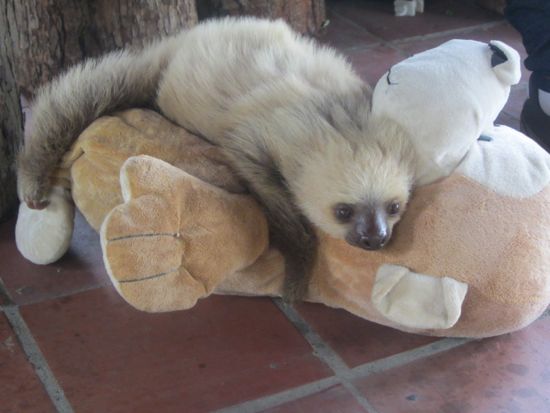The Best Tourist Attraction in Guayaquil
I’ve managed to (mostly) pull myself together after eating tachos and doing puzzles in my pajamas, so today I’m going to jump back to Guayaquil, Ecuador.

Guayaquil is not the capital of Ecuador, but it is the largest city in the country. It used to suffer from a bad reputation, but has been cleaned up over the past few years, with a shiny malecón (riverfront boardwalk – I didn’t know what it meant, either) and modern airport.
Besides the malecón, the main tourist attraction is the Parque de las Iguanas. It’s a small square in downtown Guayaquil that’s teeming with big, fat, skin-shedding iguanas. They mingle with pigeons and tourists, flocking to the old ladies on benches who toss out food.

It’s weird, but cool.
However. There is another, bigger, better tourist attraction in Guayaquil, and it wasn’t in my guidebook. Also – it’s free.
The Parque Histórico is a ‘living museum,’ an 8-hectare park divided into three zones: Wildlife Zone, Traditions Zone, and Urban Architectural Zone.

Put simply, it’s a zoo designed with natural habitats in mind. You can follow a boardwalk through four regional ecosystems and see the animals that live there. The enclosures are separate, but there are no bars or glass.
If you follow Lateral Movements on Facebook, you’ve probably noticed that I have a minor obsession with animals. Most of my photos have to do with either food or animals, and I have to make a real effort to step outside of that cycle. But that’s okay, because who doesn’t like animals?
So I was in heaven at the Parque Histórico, especially because the first thing I saw was a BABY SLOTH.

It was cuddling a stuffed monkey and I called on all of my willpower not to touch it. Instead, I lingered aggressively, hoping that the ranger girl would offer to let me hold it.
She did not.
Once I tore myself away from the baby sloth, I noticed that we were surrounded by adult sloths (in a temporary cage) and various squawking birds.
“This is the best place ever,” I may or may not have shrieked.
The boardwalk trail took us through Tropical Dry Forest, where we saw more sloths, parrots, a baby deer, and a fox.

In the Mangrove Forest, there was a harpy eagle, which was pretty amazing because 1) it was a huge eagle and 2) it was a harpy, like out of greek mythology.

In the Flooded Savannah Forest, we spotted Brazilian tapirs and ocelots. We had an extended debate about whether or not one of the ocelots was a jaguar, then realized that it was bigger because it was pregnant. I wanted to hang around for a while, just in case it decided to give birth (BABY OCELOTS!), but Jared was not so optimistic.

Last was the Drizzle Forest, which, I decided, is definitely a made-up name by the park people. “We can’t call it ‘rainforest’ because people will get confused.” “How about ‘Drizzle?'” “Sweet. Done.”
Here we walked past monkeys, crocodiles, and the crab-eating raccoon, which looked almost nothing like the cat-food-eating raccoons of my youth.
Besides the animals, there are old colonial buildings, mock peasant houses, and fruit orchards.
But after the animals, the buildings were only mildly interesting.
I know that zoos are kind of controversial, and I can understand why. And although it felt like being ‘in the wild’ to me, it probably felt less so to the animals. But it was well-maintained, much less restrictive than traditional zoos, and free!
Did I mention free?
Opening hours are Wednesday to Sunday, 9:00AM to 4:30PM, but check before you go as details are subject to change.
The Parque Histórico Guayaquil is located at KM 1.5 Vía Samborondón y Av. Esmeraldas. You can take a taxi or public bus #81 from the bus terminal- tell the driver where you’re going. You’ll have to get off at the McDonald’s, cross the busy highway, and walk a few hundred meters down the road to get there. Note that we tried to take #81 back from the opposite side of the street and wound up on an hourlong wild goose chase that did not go back to the terminal. So. Maybe a taxi back would be prudent.






How is it that guidebooks ALWAYS seem to manage to omit the one place that is the coolest? I don’t know how they manage it, but invariably, this seems to be the case!
Oh man, that baby sloth seriously is adorable. We saw an adult sloth recently at the Singapore zoo, but it was raining out so it was all wet and drippy, and not nearly so cute!
We saw an adult sloth who was sleeping in its food bowl – convenient, I guess, but kind of low on the cuteness factor! I can only hope that when the guidebooks update they get with the program and include this place. But then again, some things are best discovered on your own.